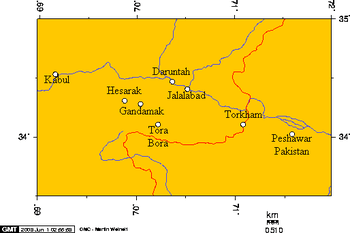Tora Bora
Coordinates: 34°07′00″N 70°13′00″E / 34.116667°N 70.216667°E
Tora Bora (Pashto: توره بوړه, Black Cave), known locally as Spīn Ghar (Pashto: سپین غر, White Mountain), is a cave complex, part of the White Mountains (Safēd Kōh) of eastern Afghanistan. It is situated in the Pachir Aw Agam District of Nangarhar, approximately 50 km (31 mi) west of the Khyber Pass and 10 km (6.2 mi) north of the border of the Federally Administered Tribal Areas in Pakistan. Tora Bora was known to be a stronghold location of the Taliban, used by military forces against the Soviet Union during the 1980s. Tora Bora and the surrounding Safēd Kōh range had natural caverns formed by streams eating into the limestone.[1][2]


Geology
The lithological nature of Tora Bora is predominantly metamorphic gneiss and schist.[3]
Military base
During the U.S. invasion of Afghanistan the cave complex was one of the strongholds of the Taliban and Al-Qaeda, according to Donald Rumsfeld.[4] It was the location of the December 2001 Battle of Tora Bora, and suspected hideout of Al-Qaeda leader Osama bin Laden.[4] It was reported that in 2007, U.S. intelligence suspected Osama bin Laden planned to meet with top Al Qaeda and Taliban commanders at Tora Bora prior to the launch of a possible attack on Europe or the United States of America.[5]
Caves
Tora Bora was variously described by the western media to be an "impregnable cave fortress" housing 2,000 men complete with a hospital, a hydroelectric power plant, offices, a hotel, arms and ammunition stores, roads large enough to drive a tank into, and sophisticated tunnel, and ventilation systems.[6]
Both the British and American press published detailed plans of the base.[7][8] When shown a plan during an NBC interview, Donald Rumsfeld of the United States Secretary of Defense said "This is serious business, there's not one of those, there are many of those".[9][10][11]

An elaborate military operation was planned which included deployment of the CIA-US Special Operations Forces team with laser markers to guide non-stop heavy air strikes during 72 hours.[12] When Tora Bora was eventually captured by the U.S. and Afghan troops, no traces of the supposed "fortress" were found despite painstaking searches in the surrounding areas. Tora Bora turned out to be a system of small natural caves housing at most, 200 fighters. While arms and ammunition stores were found, there were no traces of the advanced facilities claimed to exist.[11][13]
In an interview published by PBS, a Staff Sergeant from the U.S. Special Forces Operational Detachment Alpha (ODA) 572 described the caves:[14]
Again, with the caves, they weren't these crazy mazes or labyrinths of caves that they described. Most of them were natural caves. Some were supported with some pieces of wood maybe about the size of a 10-foot by 24-foot room, at the largest. They weren't real big. I know they made a spectacle out of that, and how are we going to be able to get into them? We worried about that too, because we see all these reports. Then it turns out, when you actually go up there, there's really just small bunkers, and a lot of different ammo storage is up there. – Jeff, Staff Sgt. ODA 572[14]
Air-strikes
The United States Air Force performed an air-strike at this location during December 2001.[15]
See also
References
- ↑ Robert Lee Hadden (2005). Adits, Caves, Karizi-Qanats, and Tunnels in Afghanistan: An Annotated Bibliography.
- ↑ M.A. Weaver - report published September 11th 2005 by the New York Times Magazine [Retrieved 2015-11-14]
- ↑ M. Bahmanyar - text published Osprey Publishing, 20 April 2012, 64 pages, ISBN 1780966296 [Retrieved 2015-11-15]
- 1 2 Donald Rumsfeld, Known and Unknown: A Memoir, Sentinel, 2011, p. 401
- ↑ Eric Schmitt & Thom Shanker (May 5, 2011), Long Pursuit of Bin Laden, the ’07 Raid, and Frustration, The New York Times .
- ↑ Steve Rose, hunt for bin Laden - Tora Bora, guardian.co.uk .
- ↑ Tora Bora: Al-Qaida's last stronghold, The Guardian, 20 December 2006.
- ↑ Bin Laden's mountain fortress
- ↑ Adam Curtis (Director) (October 20 – November 3, 2004). The Power of Nightmares: The Rise of the Politics of Fear (TV documentary). BBC Two.
- ↑ Steve Rose (May 4, 2011). "did Osama bin Laden build such a drab HQ?". Guardian.
- 1 2 Edward Jay Epstein (December 11, 2001), Lair of bin Laden .
- ↑ The CIA Museum
- ↑ Matthew Forney (December 11, 2001). "The Tora Bora Caves". Time. .
- 1 2 Against Terror: Interview: U.S. Special Forces ODA 572, PBS
- ↑ Headquarters of the U.S. Air force (Office of Lessons Learned - AF/XOL). Operation Anaconda An Air power perspective (document/AFD-140917-026.pdf) (PDF). Air Force Historical Studies Division 7th February 2005, 133 pages, U.S. Air force. Retrieved 2015-11-21. External link in
|publisher=(help)
